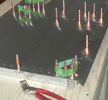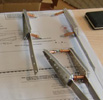


random user submitted photo
SNX-T01: Removal of vertical stabilizer
17 posts
• Page 2 of 2 • 1, 2
Re: SNX-T01: Removal of vertical stabilizer
Noel,
I agree with what you say about the discontinuity of a doubler spanning the area each side of the hole. However, Sonex does just that for the 1/2" oblong hole I had to drill into the top longeron for the windshield bow.
I created a taper in the load distribution when I recently was working those longerons. In addition to the stock Sonex doubler, I bent a piece of 0.032" 2024T3 that spans inside both legs of the longeron from outside the forward and rear wing attach angle gusset plates.
I don't see why the longeron in the tail could not receive a similar type of tapered doubler.
Rick Caldwell
Xenos 0057
I agree with what you say about the discontinuity of a doubler spanning the area each side of the hole. However, Sonex does just that for the 1/2" oblong hole I had to drill into the top longeron for the windshield bow.
I created a taper in the load distribution when I recently was working those longerons. In addition to the stock Sonex doubler, I bent a piece of 0.032" 2024T3 that spans inside both legs of the longeron from outside the forward and rear wing attach angle gusset plates.
I don't see why the longeron in the tail could not receive a similar type of tapered doubler.
Rick Caldwell
Xenos 0057
- racaldwell
- Posts: 400
- Joined: Thu May 22, 2014 4:52 pm
Re: SNX-T01: Removal of vertical stabilizer
racaldwell wrote:I don't see why the longeron in the tail could not receive a similar type of tapered doubler.
Rick - Tapered doublers could work, if engineered properly. But that's not what the poster seemed to be asking about - they mentioned simply sandwiching the longerons with equally-thick pieces of material on both sides. Keep in mind this appears to be a relatively new builder who's bought a partially-completed kit and has been asking for help and advice on how to evaluate the condition of the construction.
I think its dangerous to assume that any random person on the internet understands the implications of any advice; or that they'll "know what to do" based on a brief description (without providing a detailed and explicit set of items/shapes/materials). In this case simply saying "yeah a doubler will work" leaves out all of the nuance and important bits about needing to engineer things correctly to spread loads properly.
And in the end, I still think replacing the longeron (with who knows what other issues it has) is much faster and easier than trying to engineer a bunch of fixes with additional materials. Plus, that extra material (and associated fasteners) are all going to add up to a heavier airplane with more bits and parts to inspect and maintain across the years.
--Noel
- NWade
- Posts: 527
- Joined: Mon Aug 08, 2011 3:58 pm
Re: SNX-T01: Removal of vertical stabilizer
Yes, valid concerns there. Once I didn't take the doubler all the way back to the next truss station on my One Design repair when the landing gear mount bushings were torn off the sides of the longeron. A few years later, I had a crack. And another repair to do. Not fun. Also learned not to land tailwheel first.
Rick Caldwell
Xenos 0057
Rick Caldwell
Xenos 0057
- racaldwell
- Posts: 400
- Joined: Thu May 22, 2014 4:52 pm
Re: SNX-T01: Removal of vertical stabilizer
SP1 wrote:Kerry recommends I replace the longeron or weld the holes shut. The former is the most straightforward, albeit the most labor intensive. The latter may affect the temper of the surrounding metal through annealing.
That's what I suspected.
Replacing the longerons is really not as big a task as it might seem, it might look that way because they're long and hold that whole aft fuselage/turtledeck together, but really, if you put your mind to it, in a month's time you'll have long forgotten about it and you will have moved on to other things. On the contrary, if you decide on a less optimal solution it will haunt you throughout the rest of your build and flying future.
Just be careful drilling out the rivets and you'll be fine. What I would do then is cut the bad longerons lengthwise with a jigsaw or bandsaw right at the corner so you have 2 long flat pieces for each longeron which you can then clamp to the new angle, aligning the outer edges, and use as a template. Given you will have to drill the new angle to #30 size straight away, It will be safer having the thicker metal of longeron to use as a drilling template rather then the 0.025" skins. also, you'll be able to use the drill press. Of course there are other methods but that's how I would do it, When I stuffed up my wing rigging and had to remake the vertical forward fuselage angles I did the same thing and it worked out great.
SP1 wrote:The third alternative would be a doubler. Would bridging the area with an aluminum piece as thick as the longeron be sufficient? If it's as thick, it should take the loads fine. If I sandwich the damaged longeron on both sides, then the bending axis will be the same (or is that overkill).
Is this your idea or did Kerry suggest this? (I doubt he would to be honest).
If it's your idea, think of the following, 2 things:
1) When the day comes for your CofA inspection, the authorized person will ask you to remove all inspection covers and he will no doubt notice this "fix". He will then almost certainly ask you to justify your thinking behind this "fix", if you have an email from the factory telling you that's an acceptable solution, then your good. If you don't however, he might ask you for the necessary stress calculations etc. you have done to convince you that the fix is adequate.
2) Ignoring the above, think of your safety, I urge you to have a look at the pictures in these 2 documents. It still baffles me how these thick aluminum spars holding the V-tail to this Waiex just sheared like they were made of paper:
https://dms.ntsb.gov/public/52000-52499 ... 525944.pdf
https://dms.ntsb.gov/public/52000-52499 ... 497859.pdf
Michael
Sonex #145 from scratch (mostly)
Taildragger, 2.4L VW engine, AeroInjector, Prince 54x48 P-Tip
VH-MND, CofA issued 2nd of November 2015
First flight 7th of November 2015
Phase I Completed, 11th of February 2016
http://www.mykitlog.com/rizzz/
Sonex #145 from scratch (mostly)
Taildragger, 2.4L VW engine, AeroInjector, Prince 54x48 P-Tip
VH-MND, CofA issued 2nd of November 2015
First flight 7th of November 2015
Phase I Completed, 11th of February 2016
http://www.mykitlog.com/rizzz/
- rizzz
- Posts: 869
- Joined: Tue Jun 21, 2011 2:07 am
- Location: Wollongong, NSW, Australia
Re: SNX-T01: Removal of vertical stabilizer
Thanks Mike for the links, and greatly appreciate your thoughts. Very interesting read. I had heard about this accident but never saw the photos.
The doubler alternative was mine, and put out there to hear opinions. I've also heard about using same material rivets to "fill" in holes. Since most holes here are either large or connected to other holes, this was not an option for this case.
In addition to Ron Wanttaja's book, sitting on my desk now, I was introduced to AC No: 43.13-1B. Acceptable methods to Aircraft inspection and repair. Link is below for anyone else interested. There is a section on tapered doublers.
https://www.faa.gov/documentLibrary/med ... w-chg1.pdf
I'm going to replace the longeron and the spars. Still going through the already assembled parts to see if there are other issues. For the most part, things look good. As another person on another blog said, someone probably just got burned out. Very understandable.
Thanks again all for the information and the concern.
The doubler alternative was mine, and put out there to hear opinions. I've also heard about using same material rivets to "fill" in holes. Since most holes here are either large or connected to other holes, this was not an option for this case.
In addition to Ron Wanttaja's book, sitting on my desk now, I was introduced to AC No: 43.13-1B. Acceptable methods to Aircraft inspection and repair. Link is below for anyone else interested. There is a section on tapered doublers.
https://www.faa.gov/documentLibrary/med ... w-chg1.pdf
I'm going to replace the longeron and the spars. Still going through the already assembled parts to see if there are other issues. For the most part, things look good. As another person on another blog said, someone probably just got burned out. Very understandable.
Thanks again all for the information and the concern.
- SP1
- Posts: 120
- Joined: Sat Sep 10, 2016 2:04 am
Re: SNX-T01: Removal of vertical stabilizer
Hello all,
I was finally able to remove the tail cone longeron. Bit of work to get out. In case anyone needs to do that, these are my thoughts on how best to do it
Remove turtle deck skin first. Most of it is held in with rivets, which you can drill out. There is the two bolts in the front though. You can actually sneak in a 3/8 wrench in the gap between the cross beam and skin (no need to drill holes in the cross beam), then unscrew it. You will also need to remove the top rivets of teh tail cone side panels to slip the turle deck skin out. Next you can remove the bolts that go through the splicer plate. You can just pull the entire longeron out!
I was finally able to remove the tail cone longeron. Bit of work to get out. In case anyone needs to do that, these are my thoughts on how best to do it
Remove turtle deck skin first. Most of it is held in with rivets, which you can drill out. There is the two bolts in the front though. You can actually sneak in a 3/8 wrench in the gap between the cross beam and skin (no need to drill holes in the cross beam), then unscrew it. You will also need to remove the top rivets of teh tail cone side panels to slip the turle deck skin out. Next you can remove the bolts that go through the splicer plate. You can just pull the entire longeron out!
- SP1
- Posts: 120
- Joined: Sat Sep 10, 2016 2:04 am
Re: SNX-T01: Removal of vertical stabilizer
Well done! It is a bigger challenge to rework than to do it the first time.
Bryan Cotton
Poplar Grove, IL C77
Waiex 191 N191YX
Taildragger, Aerovee, acro ailerons
dual sticks with sport trainer controls
Prebuilt spars and machined angle kit
Year 2 flying and approaching 200 hours December 23
Poplar Grove, IL C77
Waiex 191 N191YX
Taildragger, Aerovee, acro ailerons
dual sticks with sport trainer controls
Prebuilt spars and machined angle kit
Year 2 flying and approaching 200 hours December 23
-

Bryan Cotton - Posts: 5489
- Joined: Mon Jul 01, 2013 9:54 pm
- Location: C77
17 posts
• Page 2 of 2 • 1, 2
Who is online
Users browsing this forum: No registered users and 46 guests







